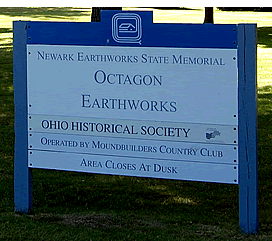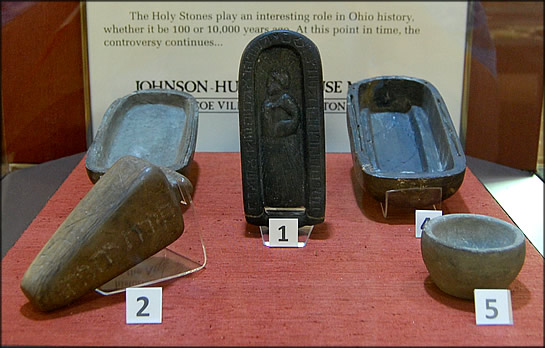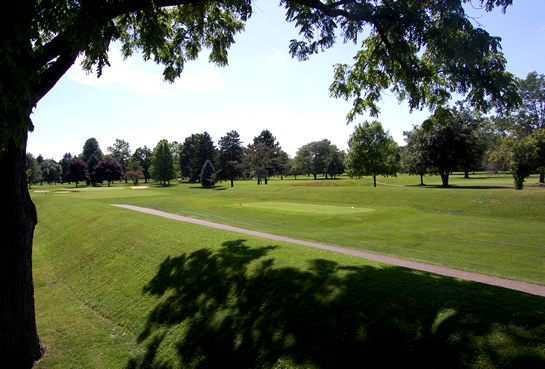The Bluebird Of History (And Pseudohistory)
May Be In Your Own Backyard:
Newark Holy Stones, Mounds
These works are so complicated, that it is impossible to
give anything like a comprehensible description of them.
— Ephraim Squier and Edwin Davis
commenting on the Newark Mounds (1847).
By Ron Fritze from Athens, Alabama
Posted September 24, 2009
Last year I wrote an essay about the history of the Newark Holy Stones.  They are thought by some to be relicts of ancient Hebrews who migrated to the region that we now know as the state of Ohio. I can understand immigrating to Ohio. That is exactly what some of my ancestors did when they came to America. Itís a beautiful and bountiful region. They are thought by some to be relicts of ancient Hebrews who migrated to the region that we now know as the state of Ohio. I can understand immigrating to Ohio. That is exactly what some of my ancestors did when they came to America. Itís a beautiful and bountiful region.
The story of the ancient Hebrews and their relicts is not so pretty. Mainstream scholars consider the Holy Stones to belong to the phenomenon of archaeological hoaxes that were common in nineteenth century America. For those who consider evidence important in establishing fact and truth, mainstream scholars certainly have the best argument. With them, I think the Newark Holy Stones are relicts of an antebellum hoax and not artifacts of pre-Columbian Jewish settlers in the Americas.
At the same time, fake or genuine, the Newark Holy Stones are important artifacts and well worth visiting.
This summer I had an opportunity to see the Holy Stones. I had driven up to Indiana to visit my Mom and we decided to make a day trip over to Coshocton, Ohio, the home of the Newark Holy Stones. Coshocton is about an hourís drive to the northeast of Columbus. It is located in pleasant, hilly country that is heavily wooded. During the temperate summer the landscape is a glorious deep green, which particularly caught my attention since six weeks earlier I had experienced the dry, dusty brown of Egypt with its blast furnace temperatures.
Exterior of the Johnson-Humrickhouse Museum
History and Pseudohistory on Display
The Holy Stones are on exhibit in the Johnson-Humrickhouse Museum in historic Roscoe Village. A visit to the Johnson-Humrickhouse is very much recommended for those interested in local history and some interesting artifacts from the pseudohistory of North America.
When you drive into Coshocton, be sure to follow the signs to Roscoe Village, not to downtown Coshocton. Roscoe Village is a collection of historic buildings and little shops. Because a canal once flowed through Coshocton, they display a replica of a canal boat. The one I saw was a cargo-carrier, built to be piled high with goods. It also served as a home for the canal boatman and his family. I wished that they had displayed a passenger boat, too. From what I have read, travel on a canal boat, though slow, was quite comfortable and the meals served to passengers were supposed to be excellent.
Model of a Canal Boat at Roscoe Village
The Johnson-Humrickhouse Museum turned out to be a modern two story building and quite a nice facility. It is probably best known for its exhibit of the Newark Holy Stones, but it also features nice collections of artifacts from Ohioís various moundbuilder cultures, along with items from frontier and late nineteenth-century Ohio. There is also a display of other Native American artifacts from the Plains and Southwestern tribes, including some Kachina dolls that have nothing to do with Ohio and the Coshocton region. Also having no connection to Ohio history, extensive collections of Chinese and Japanese artifacts are on display in a gallery on the second floor.
An Eclectic Array Whets the Palate
Of History Buffs and Collectors.
These off-topic collections reflect the passions of the museumís Johnson-Humrickhouse family benefactors. The Johnson brothers, David and John, like many well-to-do Americans, collected for a hobby. They were lesser versions of Edward Ayer, the Chicago businessman, whose collection of artifacts and books about Native Americans have so enriched the Newberry Library and the Field Museum of Natural History in Chicago. Besides its archaeological and historical exhibits, the Johnson-Humrickhouse Museum supports the art and culture in the Coshocton area.
The Newark Holy Stones formed part of the collection of David Johnson, who purchased them in 1861 because he thought they were authentic. He later changed his mind and attempted to sell them, but found that there was no one willing to buy for an amount close to what he paid for them. So he held on to them and they form part of the donation made by the Johnson brothers. Full size replicas of the Holy Stones are available for purchase.
At the museum, the Holy Stones are located on a large landing where the stairs lead to the second-floor terminate. Many visitors to the museum come especially to see the Holy Stones Ė and a significant number of these tourists believe the stones are authentic. The exhibit takes an even-handed approach that neither affirms nor denies the authenticity of stones, although Johnson-Humrickhouse Museum has hosted conferences that have questioned their genuineness.
The Holy Stones consist of the Key Stone, the Decalogue Stone with a stone box to contain it, and a stone bowl. Other supposed Hebrew artifacts were found in the Newark mounds, but they were immediately denounced as fakes and have been lost.
A Newark mound rises in the foreground.
The Encroaching City
Coshocton is about a thirty-minute drive from Newark, the home of the mounds where the Holy Stones were found. Newark is a pleasant, prosperous town, which I suspect has become something of a bedroom community for people working in Columbus.
Only a portion of the original Newark mounds have survived because the growth of the town has engulfed them. The Hopewell Culture built the mounds about 2,000 years ago. They are considered to be the largest geometrical complex ever built. What survives is the Great Circle Mound, which once served as the location of the Licking County Fairgrounds and is now a lovely park. There is an impressive visitor center with some informative displays and videos. The day we visited, some young boys were doing wheelies on a smaller ridge of mound. I was taking some pictures of it and I suspected they were not supposed to be riding on the mound. They took off when I got them in a picture.
Squier and Davisís survey shows the complexity and,
in terms of mid-nineteenth-century archaeological knowledge,
incomprehensible nature of the Newark Mounds.
A bit over a mile away from the Great Circle Mound is the remaining major survival of the Newark Mounds — the Octagon complex, an octagon-shaped mound connected to circular mound. You get there by driving through a
largely residential neighborhood. The Octagon mounds were built for calendrical purposes to track celestial movements through the seasons. At the moment, the Octagon works are part of the Moundbuilders Country Club. Originally the city of Newark wanted to make the mounds a park but lacked the money.  A group of the more well-to-do residents wanted the land for a golf course. So in 1911 the city leased the complex to the country club on the condition that the land remain open to the public. A group of the more well-to-do residents wanted the land for a golf course. So in 1911 the city leased the complex to the country club on the condition that the land remain open to the public.
So, if you visit these mounds, you should be prepared to dodge flying golf balls and speeding golf carts. Although the Licking County Commission transferred the ownership of the land to the Ohio Historical Society, the Moundbuilder Country Club was granted such a long lease that the Octagon complex will not truly return to being public property during the lifetime of most of us.
As one of the archaeologists on a video shown in the visitor center complained, Ohio has the richest collection of ancient mounds in the entire United States and the weakest laws protecting antiquities. But donít let that deter you from visiting Newark — lovely town, great mounds. Check it out.
More Mounds
If mounds interest you, I would also recommend visiting the mound complex at Chillicothe, the Fort Ancient Mound, the Great Serpent Mound, and the Fort Hill Mound — all in southern Ohio.
The Chillicothe site recently came into the possession of the National Park Service. When I visited it, the park was in transition. It is also worth seeing the nearby Scioto River.
Fort Ancient, along with the Great Serpent and Fort Hill, are operated by the Ohio Historical Society, which does a wonderful job. Fort Ancient is a great place for a picnic and a good walk.
The Great Serpent is located in a pretty setting, but its purpose remains ill understood.
The most isolated of these mounds is Fort Hill, but it is really worth the trip for the adventurous among us. When you drive up to the park at Fort Hill, youíll find a small visitor center with clean restrooms and a hand pump that dispenses fresh, cool water. Fort Hill is literally located on a hill — and a steep one at that. There is a hiking path that takes about two hours to do. The hike is not for anyone unaccustomed to exercise but is well worth the effort. What is unique about Fort Hill is that it is overgrown by large, old trees. It appeared to me that the land had never been cleared for farming, which is not surprising given the roughness of the topography. Visiting Fort Hill allows the traveler to see the mounds through the eyes of the amateur archaeologists Ephraim Squier and Edwin Davis, who surveyed the mounds during the 1840s.
As Robert Louis Stevenson said of the lower Midwest in 1879, ďAll through Ohio, Indiana, Illinois, and Iowa, or for as much as I saw of them from the train, and in my waking moments, it was rich and various and breathed in an elegance peculiar to itself.Ē
Click on the black panther to read about Ron Fritze's new book,
Invented Knowledge: False History, Fake Science, and Pseudo-religions. |








 A group of the more well-to-do residents wanted the land for a golf course. So in 1911 the city leased the complex to the country club on the condition that the land remain open to the public.
A group of the more well-to-do residents wanted the land for a golf course. So in 1911 the city leased the complex to the country club on the condition that the land remain open to the public.